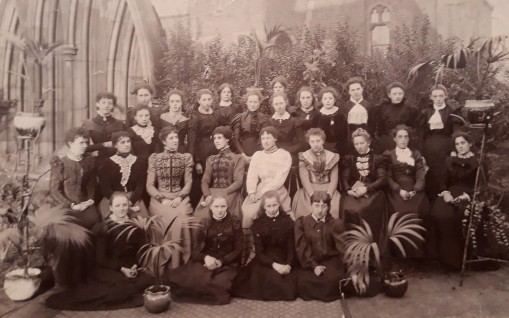12 March 2020
In February 1853, five Holy Child Sisters were sent to Preston to answer the call of the Jesuit fathers to take charge of their schools. The fathers had originally requested the SHCJ to come to Preston as the small community prepared to leave Derby in 1848. M. Emily Bowles related to John Henry Newman in 1851 that the SHCJ were offered ‘the beautiful schools and small Convent at Preston’ as well as St Leonards-on-Sea. M. Emily identifies the ‘very pressing wishes and presentations’ of Bishop Wiseman, given ‘more weight than was necessary by Dr Asperti’ who was ‘naturally anxious to serve a mission alone’ as the cause for the choice of St Leonards. Her letter goes on to lament the trials endured by the sisters and Cornelia as she confides in Newman:

Are we to uproot ourselves again, & be driven a second time from our flourishing work just as it is putting forth its strength & vigour – why did we come here & not go to Preston? […] Oh! If you knew how Revd Mother has been tried and what it is to see her so tried
Despite the difficulties faced in their second convent, Cornelia was eventually able to fulfil the Jesuit fathers’ wishes. With M. Lucy Woolley as their superior, five sisters started the SHCJ’s work in Preston at St Ignatius’ School. From the earliest days of their presence in Preston, the SHCJ’s work bore fruit. In addition to St Ignatius’, the sisters went to manage more day schools and Sunday schools: St Wilfrid’s in 1854, St Walburge’s in 1857 as well as the English Martyrs’ and St Mary’s in 1871. On 13th February 1871, M. Lucy writes with enthusiasm and pride in the sisters under her supervision. She describes the taking on of the English Martyrs’ schools as a ‘brilliant and energetic opening’ and ‘the crowning work of the year’ which enabled the Preston Sisters ‘to pursue our labours in the town in peace and union’.

Their efforts were rewarded with praise and respect from school inspectors and other organisations. The SHCJ Annals quote the Catholic Truth Society’s statement in their report that the success of Catholic education in Preston was ‘owe[d] in great measure to the untiring energy, devotion and great teaching ability of the sisters of the Holy Child Jesus’. As early as March 1855, Mr Stokes in the Journal of the London Poor School Committee refers to St Ignatius as ‘this fine school’ and remarks that it has ‘made marked progress during the last year’ with pupil teachers teaching ‘without help from monitors’. Stokes also comments that the night school’s ‘value is very highly estimated’.
From 1853 the SHCJ in Preston were dressed as seculars, wearing light grey silk bonnets and veils, which were replaced in 1854 by ‘the large black poke bonnet with a black silk curtain and crepe or gauze veil’ as the Annals record. As M. Theophila was compiling the SHCJ Annals 1846 – 1876 in 1904, she notes that the Preston sisters still wear their poke bonnets in winter ‘finding them a better protection from the wind & cold than their veils’.
SHCJ education in Preston expanded further after the Society purchased number 23 Winckley Square in the Spring of 1875 while renting and later purchasing number 22.
This was to become the High School. It started as the premises for the SHCJ’s private school for children aged from 3 – 18 and for the pupil teachers. By 1906 the high school and pupil teacher numbers reached 105 and 66 respectively.
The Preston papers within the Provincialate archive contain several letters and accounts recording precious memories of SHCJ sisters and Winckley Square old girls. An anonymous, undated set of notes –probably a response to a request for information made by M. M. Austin in 1924 – describes the achievements alongside the idiosyncrasies of Preston SHCJ. M. Maria is remembered to have been keen to save the gas used to heat the school, ‘I once heard her say that she would haunt us if we wasted it’. Her calm management of the children is celebrated by the writer:
The parents of the children were so satisfied with the teaching of the little ones. Her control was wonderful – a tap on the window-pane with her thimble (she nearly always had sewing in her hand) was all sufficient to bring them in from the Park to the Class room.
The same account credits M. St Rita for her work introducing drawing classes and higher-level certificates. In her own reminiscences within a 1924 letter to M.M. Austin., M. St Rita humbly describes the work of her generation as ‘just throwing in rubble for the foundation of what was to come later’.

An old girl of 1909 – 1910 recalls dancing being held each morning interval in the school hall. One sister who came to Preston in 1943 remembers the ‘vitality’ of the girls she taught English to and spirited lessons performing Shakespeare. She recounts Sister Mary Fidelis being reassured that ‘the scholastic standards of Winckley Square were being maintained’ as she checked on the class and found ‘a convincing rendering of an enraged Cleopatra’. The sister also remembers a production of the Pirates of Penzance with ‘such a lively chorus that the tunes resounded around the school’. A Winckley Square alumnus recalls the hard work and fun enjoyed around the Mid-Lent play in the 1950s which was ‘a tremendous occasion preceded by months of rehearsals’. She creates an evocative image of the work of ‘patient Mother Mary Dismas’ who ‘mouth bristling with pins, coaxed playclothes into wonderful shape around one’.
Sadly, both Emily Bowles and Lucy Woolley were to leave the Society over actions taken with property and finance in M. Emily’s case and M. Lucy’s grave disagreement with Cornelia over the Rule. Nevertheless, it is inspiring to see how the dream of an SHCJ foundation in Preston became a reality. The roots planted by M. Lucy and the early Preston sisters flourished into successful, creative and warm spirited schools.



Comments are closed.